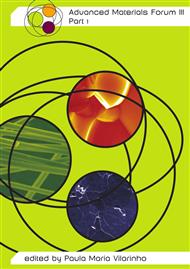[1]
E. Clar: Polycyclic Hydrocarbons (Academic Press, New York 1964).
Google Scholar
[2]
R.G. Harvey: Polycyclic Aromatic Hydrocarbons (Wiley-VCH, New York 1997).
Google Scholar
[3]
H. Oikawa, H. Nakanishi: Optical Properties of Polymer Nanocrystals, in: H. Masuhara, H. Nakanishi, K. Sasaki (Eds. ) Single Organic Nanoparticles ( Springer, Heidelberg 2003).
Google Scholar
[4]
H. Toyotama: US Patent 5354563.
Google Scholar
[5]
D.L. Brown: US Patent 5958329.
Google Scholar
[6]
T. Seko, K. Ogura, Y. Kawakami, H. Sugino, H. Toyotama, J. Tanaka: Chem. Phys. Lett. Vol. 291 (1998), pp.428-444.
Google Scholar
[7]
H. Nakanishi, H. Oikawa: Reprecipitation Method for Organic Nanocrystals, in: H. Masuhara, H. Nakanishi, K. Sasaki (Eds. ) Single Organic Nanoparticles ( Springer, Heidelberg 2003).
DOI: 10.1007/978-3-642-55545-9_2
Google Scholar
[8]
D. Horn, J. Rieger: Angew. Chem. Int. Ed. Vol. 40 (2001) pp.4330-4361.
Google Scholar
[9]
B.Y. Sekunov, P. York: J. Cryst. Growth Vol. 211 (2000) pp.122-136.
Google Scholar
[10]
P. Kang, C. Chen, L. Hao, C. Zhu, Y. Hu, Z. Chen: Mater. Res. Bull. Vol. 39 (2004) p.545551.
Google Scholar
[11]
Y. Tamaki, T. Asahi, H. Masuhara: Appl. Surf. Sci. Vol. 168 (2000) pp.85-88.
Google Scholar
[12]
M. Ullmann, S.K. Friedlander, A. Schmidt-Ott: J. Nanoparticle Res. Vol. 4 (2002) p.499509.
Google Scholar
[13]
A. Fojtik, A. Henglein: Ber. Bunsen-Ges. Phys. Chem. Vol. 97 (1993) pp.252-254.
Google Scholar
[14]
Y.P. Lee, Y.H. Liu, C.S. Yeh: Phys. Chem. Chem. Phys. Vol 1 (1999) pp.4681-4686.
Google Scholar
[15]
Y. Tamaki, T. Asahi, H. Masuhara: J. Phys. Chem. A Vol. 106 (2002) pp.2135-2139.
Google Scholar
[16]
H. Masuhara, T. Asahi: Laser Ablation Method for Organic Nanoparticles, in: H. Masuhara, H. Nakanishi, K. Sasaki (Eds. ) Single Organic Nanoparticles ( Springer, Heidelberg 2003).
DOI: 10.1007/978-3-642-55545-9_3
Google Scholar
[17]
Y. Tamaki, T. Asahi, H. Masuhara: Jpn. J. Appl. Phys. Vol. 42 (2003) pp.2725-2729.
Google Scholar
[18]
T. Sugiyama, T. Asahi, H. Masuhara: Chem. Lett. Vol. 33 (2004) pp.724-725.
Google Scholar
[19]
Y.H. Chen, C.S. Yeh: Colloids Surfaces A: Physicochem. Eng. Aspects Vol. 197 (2002) pp.133-139.
Google Scholar
[20]
B. Li, T. Kawakami, M. Hiramatsu: Appl. Surf. Sci. Vol. 210 (2003) pp.171-176.
Google Scholar
[21]
L.V. Zhigilei, P.B.S. Kodali, B.J. Garrison, Chem. Phys. Lett. Vol. 276 (1997) pp.269-273.
Google Scholar
[22]
K. Kosswig, H. Stache: Die Tenside (Hanser, München, 1993).
Google Scholar


